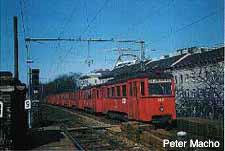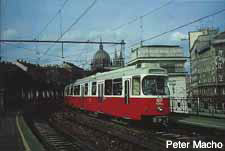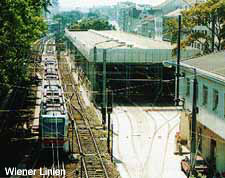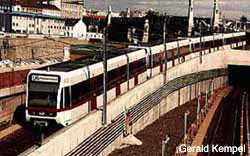E6/c6 and T/T1 Stock
N1/n2 stock was used into the early 1980s, when it was replaced by articulated bidirectional tram stock consisting of E6 motor cars and c6 trailers. When the line was converted to new metro (U6), it could not be adapted to accommodate standard metro stock due to several limitations imposed by the Otto Wagner-built stations and bridges, so the E6/c6 stock remained in service and was typically used in the formation E6-c6-c6-E6.

N1/n2 stock (Peter Macho)

E6/c6 stock (Peter Macho)
When passenger traffic increased considerably after the line had been extended, the city decided to buy new rolling stock, especially as further extensions were already being built. BWS developed a low-floor, high-capacity articulated design so that standard metro requirements could be met without having to modify the historic station architecture. These trains, called T stock, were introduced in 1994. They are 350 mm wider than E6/c6 stock, so the station platforms along the line had to be adapted accordingly. At the present, trains on line U6 run in the formation T-T-T-T or E6-c6-T-c6-E6, so that there is a car of T stock in every train for the use of disabled people. Ten additional cars of T stock entered service in early 2000.

T stock (WVB)
Even though the projected life expectancy of E6/c6 stock has not yet been reached, technical problems resulting from interoperation with T stock have led to so much wear and tear that these units need to be replaced within the next few years. As a result, 38 units of low-floor rolling stock with specifications similar to T stock were ordered from Bombardier in December 2004. As a positive side effect, the replacement of E6/c6 stock will result in full low-floor trains with higher passenger capacity and the increase of maximum speed on line U6 from 60 kph to 80 kph. It should also put an end to the frequent cancellations of trains due to technical incompatibilities between E6/c6 and T stock. After numerous delays, these trains, designated T1 stock, finally entered service in May 2008.
After looking for buyers for the E6/c6 stock, 18 of these units were sold to Regio Utrecht in May 2008.
